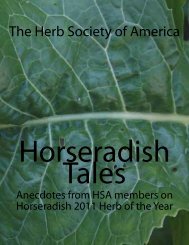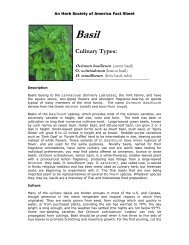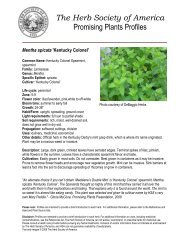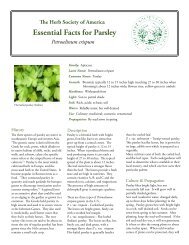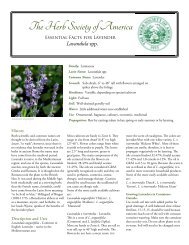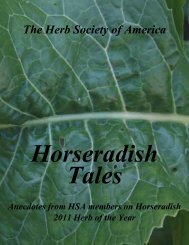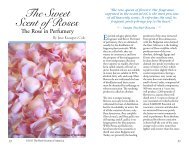Dill Anethum graveolens.indd - The Herb Society of America
Dill Anethum graveolens.indd - The Herb Society of America
Dill Anethum graveolens.indd - The Herb Society of America
Create successful ePaper yourself
Turn your PDF publications into a flip-book with our unique Google optimized e-Paper software.
<strong>The</strong> <strong>Herb</strong> <strong>Society</strong> <strong>of</strong> <strong>America</strong>’s<br />
Essential Facts for <strong>Dill</strong><br />
<strong>Anethum</strong> <strong>graveolens</strong><br />
QUICK FACTS<br />
Family: Apiaceae (Umbelliferae)<br />
Latin Name: <strong>Anethum</strong> <strong>graveolens</strong><br />
Growth: annual, sometimes biennial<br />
Light: full sun<br />
Soil: light to medium texture, welldrained<br />
Water: keep soil moist but not saturated,<br />
overhead watering at seedling stage<br />
Pests: aphids<br />
Diseases: root rot<br />
Image courtesty <strong>of</strong> Billi Parus<br />
History and Origin <strong>Anethum</strong> <strong>graveolens</strong> is believed to have its beginnings in the Mediterranean region.<br />
<strong>The</strong> plant has a long and ancient history in many countries as a culinary and medicinal herb. <strong>The</strong> earliest<br />
known record <strong>of</strong> dill as a medicinal herb was found in Egypt 5,000 years ago when the plant was referred<br />
to as a “soothing medicine.” Gladiators were fed meals covered with dill because it was hoped that the herb<br />
would grant them valor and courage. <strong>Dill</strong> seeds are <strong>of</strong>ten called “meetinghouse seeds” because they were<br />
chewed during long church services to keep members awake or kids quiet. <strong>The</strong> seeds were also chewed in<br />
order to freshen the breath and quiet noisy stomachs.<br />
Myths and Folklore <strong>Dill</strong> was believed to provide protection from witchcraft, most likely because <strong>of</strong> its<br />
strong smell. Charms were <strong>of</strong>ten made from sprigs <strong>of</strong> dill to provide protection from witchcraft; they were<br />
hung around the house or worn on the clothing. <strong>Dill</strong> was <strong>of</strong>ten added to love potions and aphrodisiacs to<br />
make them more effective. <strong>The</strong> herb was also believed to have an effect on<br />
marriages bringing happiness and good fortune. In Germany and Belgium,<br />
brides would attach a sprig <strong>of</strong> dill to their wedding gowns or they<br />
would carry it in their bouquets in the hopes that happiness would bless<br />
their marriages.<br />
<strong>The</strong> <strong>Herb</strong> <strong>Society</strong> <strong>of</strong> <strong>America</strong><br />
9019 Kirtland Chardon Road<br />
Kirtland, OH 44094<br />
phone: 440.256.0514<br />
hours: M-F, 9am-5pm (EST)<br />
www.herbsociety.org<br />
<strong>The</strong> <strong>Herb</strong> <strong>Society</strong> <strong>of</strong> <strong>America</strong> ©2009/Text taken from <strong>The</strong> <strong>Herb</strong> <strong>Society</strong> <strong>of</strong> <strong>America</strong>’s Essential Guide to <strong>Dill</strong>
How is dill used In the food industry dill is primarily used<br />
for making dill pickles. <strong>Dill</strong> seed can be used whole for this purpose,<br />
or dill weed oil might be used. Many home canners <strong>of</strong>ten<br />
elect to use the whole seed head for making pickles. <strong>The</strong> essential<br />
oil <strong>of</strong> dill is also used by the food industry for flavoring and as<br />
an ingredient in liqueurs. <strong>Dill</strong> weed, seed, and oil are frequently<br />
added to baked goods, snacks, condiments, and meat products.<br />
<strong>The</strong> fragrance industry makes much use <strong>of</strong> dill essential oil to<br />
produce soaps, perfumes, detergents, creams, and lotions. <strong>The</strong><br />
general home cook most <strong>of</strong>ten uses dill in two forms: dill seed<br />
and dill weed. Cooks <strong>of</strong>ten prefer to use dill weed because it has a<br />
stronger flavor than that <strong>of</strong> dill seed. <strong>The</strong> seeds are <strong>of</strong>ten used as a<br />
condiment, but they can also be combined with onions, cabbage,<br />
potatoes, cumin, chili powder, and paprika. Additionally, they can<br />
be added to casseroles, lamb, fish, vegetable dishes, and sauces.<br />
Chopped or whole dill weed can be added to soups, stews, casseroles,<br />
meat dishes, pasta, and eggs. It can also enhance all types <strong>of</strong><br />
sauces, dips, butters and cheeses. An especially good combination<br />
is that <strong>of</strong> salmon and dill.<br />
How do I Harvest <strong>Dill</strong> <strong>The</strong> optimum time for harvesting<br />
dill is in the early morning. <strong>The</strong> higher moisture content <strong>of</strong><br />
the plants when harvested at this time results in better flavor<br />
and the possibility <strong>of</strong> seed shattering is reduced. Do not let your<br />
dill plants bolt if you want a continuous supply <strong>of</strong> dill for harvesting, keep their tops trimmed regularly. <strong>Dill</strong> weed<br />
is best harvested before the plant is fully mature and before the flower buds have opened.<br />
<strong>Dill</strong> seed is harvested at the end <strong>of</strong> the plant’s life cycle. <strong>The</strong> flowers will be spent, the stems will start drying out,<br />
and the seeds will have turned a golden brown color. <strong>Dill</strong> seed can be easily collected by hand using the following<br />
method: First, place a brown paper bag over the seed heads and tie the opening closed. Cut the stem <strong>of</strong>f at<br />
the base <strong>of</strong> the plant. Next, hang the stems upside down in a warm, well ventilated area to dry. Take the stems<br />
down after about two weeks and crush the dried seed heads in your hands over a container to separate the seeds<br />
from the seed head. An additional method involves laying<br />
the freshly harvested seed heads on a cookie sheet<br />
and then placing them in the freezer. Remove the frozen<br />
seed heads after a few days and then rub the seed heads<br />
between your hands over a piece <strong>of</strong> paper to harvest.<br />
What about storage Fresh cut dill can be stored<br />
in the refrigerator safely for two to three days. <strong>The</strong> stems<br />
can be placed in a cup <strong>of</strong> water to help keep the leaves<br />
fresh. A majority <strong>of</strong> cooks prefer fresh dill to dried<br />
because <strong>of</strong> its superior flavor. However, there are several<br />
methods for preparing dill weed for long term storage.<br />
To dry naturally, lay freshly harvested dill on waxed<br />
paper and place it in a warm, dark spot with good air circulation.<br />
<strong>Dill</strong> weed can also be dried in a food dehydrator<br />
or frozen. <strong>The</strong> leaves should then be placed in an airtight<br />
container and stored in a dark place.<br />
Image courtesy <strong>of</strong> Billi Parus<br />
<strong>The</strong> <strong>Herb</strong> <strong>Society</strong> <strong>of</strong> <strong>America</strong> ©2009/Text taken from <strong>The</strong> <strong>Herb</strong> <strong>Society</strong> <strong>of</strong> <strong>America</strong>’s Essential Guide to <strong>Dill</strong>




